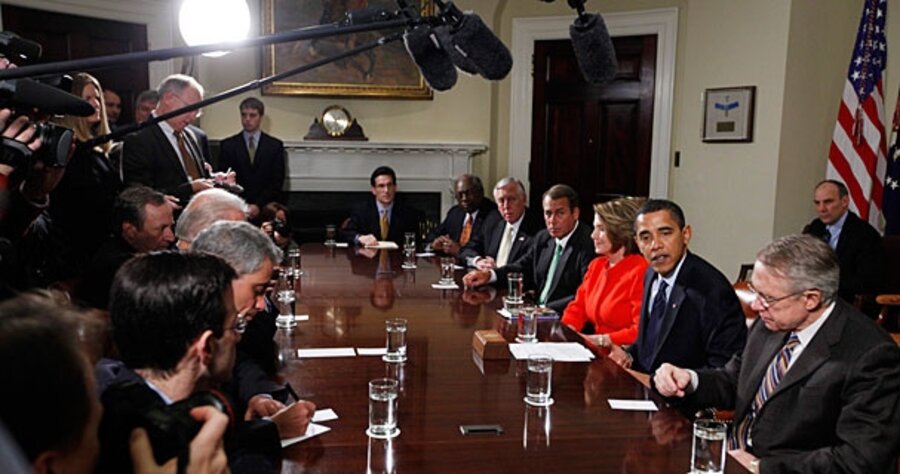States to win big in stimulus sweepstakes
Loading...
| Washington
The economic stimulus plan now moving through Congress would shower billions of federal dollars on state and local governments desperate for cash.
The House stimulus bill includes an extra $87 billion in federal aid to state Medicaid programs, for instance. It allots some $120 billion to boost state and city education programs.
There’s $4 billion for state and local anticrime initiatives in the legislation, not to mention $30-plus billion for highways and other infrastructure projects.
Overall, about one-quarter of the entire $825 billion recovery package would be devoted to activities crucial to governors, mayors, and local school boards – making them among the plan’s biggest beneficiaries.
Such aid will help needy Americans keep their healthcare, and help teachers, police officers, and other public employees keep their jobs, say Obama administration officials.
Critics say Uncle Sam is about to allocate huge sums to bail out many states and cities that got themselves in trouble by overspending in boom times.
“It will reward states that have behaved irresponsibly,” says Brian Riedl, a senior fellow in budgetary affairs at the Heritage Foundation.
This week could be a big one for the stimulus package. Individual House committees last week approved portions of the bill under their jurisdiction. Now those parts will be welded together, and the full House could vote on the package as soon as Jan. 28.
President Obama pushed hard for the bill over the weekend. In his first weekly presidential radio and video address, he said his American Recovery and Reinvestment Plan is critical to jump-starting the economy.
“It’s a plan that will save or create 3 [million] to 4 million jobs over the next few years,” said Mr. Obama.
A fact sheet released with the address asserted that programs in the bill would double America’s renewable-energy generation capacity within three years, weatherize 2 million homes, and upgrade 10,000 schools.
Congressional Republicans generally agree that Washington must act to try to aid economic recovery. But they question whether such an effort needs to cost almost $1 trillion – and they want a higher percentage of the aid to be delivered via tax cuts. (Tax cuts account for about one-third of the proposed stimulus.)
Obama invited Democratic and Republican legislators to the White House on Monday to discuss their proposals.
“We presented President Obama with our ideas to jump-start the economy through fast-acting tax relief, not slow-moving government spending programs,” said House Republican leader John Boehner of Ohio.
In contrast, proponents of the fiscal package contend that aid to state and local governments, in particular, would be an effective way to boost the economy.
For one thing, such spending would flow through existing programs and budgets, so that setting up entire new bureaucracies to spend most of the cash is not needed. The extra Medicaid funds, for instance, could be spent “very fast,” says Nicholas Johnson, director of state fiscal policy at the Center on Budget and Policy Priorities (CBPP).
Medicaid is a joint federal-state entity that provides healthcare to some 59 million needy and disabled Americans. It is one of the fastest-growing of US government programs, even in good times, and governors and legislatures in many states often struggle to find the funds to pay their Medicaid portions.
Medicaid enrollment is now increasing quickly, as it does in every recession. As people lose their jobs and incomes, they often lose their health insurance.
“This is a big concern for state budgets right now,” says Mr. Johnson.
Overall, states face deficits equal to about $350 billion over the next two years, according to CBPP figures. At least 33 have already proposed health and education cuts. Unlike the federal government, many states must balance their budgets every year, under state law.
Aid allocated by the House version of the stimulus bill would cover only about half of the shortfall states face. Still, it could keep states, cities, and towns from making difficult layoffs of teachers and police, which would add to the already-dim unemployment picture.
“We have to ensure that states don’t have to take actions that damage the economy further,” says Johnson.
Many Republicans, by contrast, say much of the state and local aid would be doled out too slowly to jolt the economy out of its doldrums. They point to a recent Congressional Budget Office study that found that less than half the money for roads, school construction, and other infrastructure projects is likely to be spent within the next two years.
Critics also argue that states spent too much in the flush times, when they should have saved against a possible downturn. They expanded Medicaid coverage, for instance, to the point where in some instances it pays for antiobesity and substance-abuse programs, says the Heritage Foundation’s Mr. Riedl.
In the 1990s, state budgets grew by about 6 percent per year. Some states, such as California and New York, now face especially acute shortfalls. “To demand that residents from other states bail out California is really unfair,” says Riedl.





